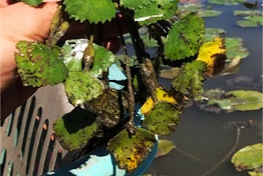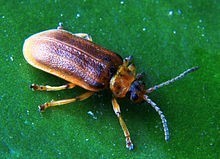Author: Jesse Vining, VT Aquatic Invasive Species Program Technician, Vermont Department of Environmental Conservation
October 2022

Water chestnut with signs of predation
During the summer, it possible to observe the invasive plant, Water chestnut (Trapa natans), with small holes scattered on their floating, triangular-shaped leaves. Some plants in various locations can be seen with up to 25% of their leaf-matter chewed through. Invasive species are often allowed to radically alter ecosystems because they lack native predators, so the fact that an insect is “snacking” on this particularly damaging plant is exciting. Likely the hungry beetle that has been found snacking is the Galerucella nymphaeae, commonly known as the Water Lily Leaf Beetle. As the name suggests, the beetle typically lives, feeds, and reproduces on water lilies, but due to the proximity of Water chestnuts there has been some crossover. The beetles are very small, rusty gold-colored creatures that mate, lay their eggs, and hatch on water lilies. Their larvae eat the leaves they were born on, which means that if there are too many larvae on one leaf it will sink, and the larvae must crawl to a new home. The adults are able to get around wetlands by lifting up their middle legs and using their wings to propel them on the surface of the water, an impressive feat of self-powered water skiing.
Galerucella nymphaeae belong to a large and global family of beetles known as Chrysomelidae. They are all leaf-eaters, and often center their whole life cycle around one plant. Water Lily Leaf Beetles may even be subclassified by their jaw sizes which give them an edge on certain types of water lilies. In a 2002 natural predation study by the US Department of Agriculture, they were recorded eating Water chestnut, but it had not shown to be “very abundant or damaging anywhere in Europe.” Another study, focused on the possibility of using them as a biocontrol in 2005 showed that Galerucella nymphaeae had no effect on the biomass or reproductive effort of the population.

Galerucella nymphaeae
So far, it has been concluded that the species is not a viable means of controlling Water chestnut in the Northeast United States. However, Galerucella nymphaeae are the cousins of a species, Galerucella birmanica, native to China that were proposed as a biocontrol method in the early 2000’s. These studies confirmed that the beetle devastated Trapa natans populations if a sufficient density of larvae was built up. Galerucella birmanica is considered a pest to the Water chestnut cultivations in China, where it is actively controlled because of the damage that it does to the crops.
While researchers are excited about the specificity of the leaf beetle’s herbivory patterns, there has been no long-term data on the topic, and there has not been any publications on the topic since 2006. One weakness of the idea is that the population of Galerucella birmanica depends on the health of the Trapa natans populations that host them for their whole lives. However, there is still interest in the idea that the beetle could become a useful tool in our arsenal of Water chestnut control.
Research in on the subject has been reestablished at Cornell University by Dr. Bernd Blossey, who was able to import the beetle from China for a quarantined study in 2018 Dr. Blossey has said that he is “working on the petition for field release to be submitted to TAG. This has been delayed due to many reasons, all related to Covid. The beetle is extremely specific, so we hope to get some green light - but I am not entirely sure when that will happen at this point.” TAG is the US Department of Agriculture’s program to regulate the research and release of non-indigenous species. Historically, biocontrol methods have often had unintentional consequences and therefore the permitting process to introduce a new species to an ecosystem is rigorous. The agency requires evidence that the species would not harm any other indigenous plant species, and the studies can last years. However unsure the future of Galerucella birmanica in this country is, its cousin the Water Lily Leaf Beetle will continue to do what it does best. Maybe it will keep adapting its refined palate to include Water chestnut.
For more information about this and other species, go to Vermont Department of Environmental Conservation Aquatic Invasive Species Program webpage.
References
Ding, J., Blossey, B., Du, Y., Zheng, F., 2006. Galerucella birmanica (Coleoptera: Chrysomelidae), a promising potential biological control agent of water chestnut, Trapa natans. Biol. Control 36, 80–90.
Ding, J., Blossey, B., 2005a. Impact of the native water lily leaf beetle Galerucella nymphaeae (Coleoptera: Chrysomelidae) attacking introduced water chestnut, Trapa natans, in the northeastern United States. Environ. Entomol. 34, 683–689.
Van Driesche, R., et al., 2002, Biological Control of Invasive Plants in the Eastern United States, USDA Forest Service Publication FHTET-2002-04, 413 p.
Zheng, F., 2004. Study on the Population Ecology of Galerucella birmanica Jacoby. Yangzhou University, China, Yangzhou.